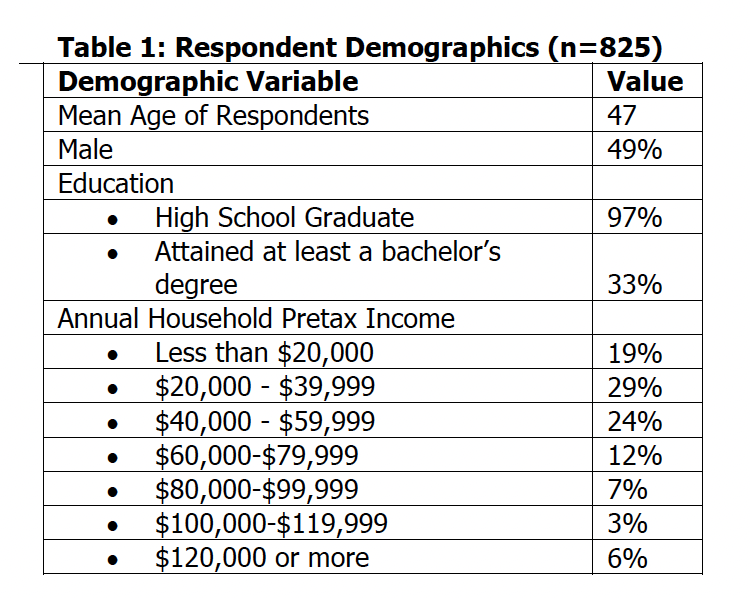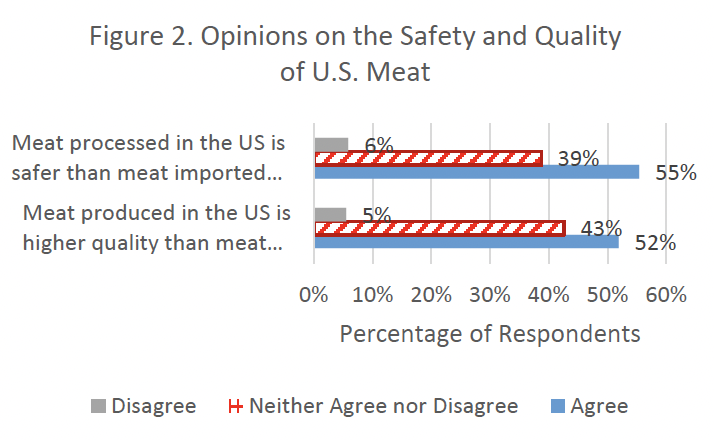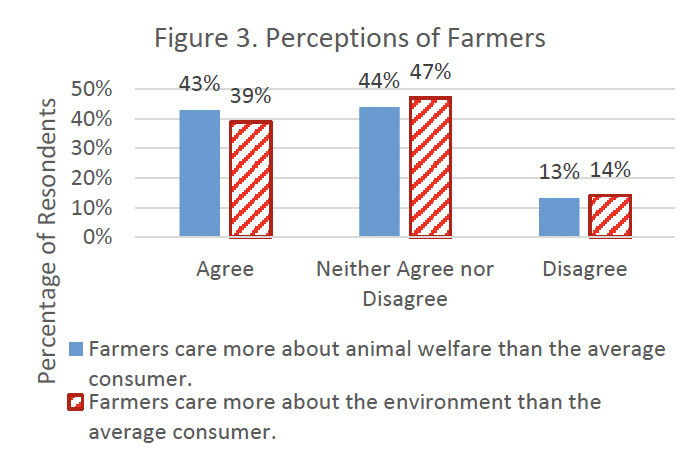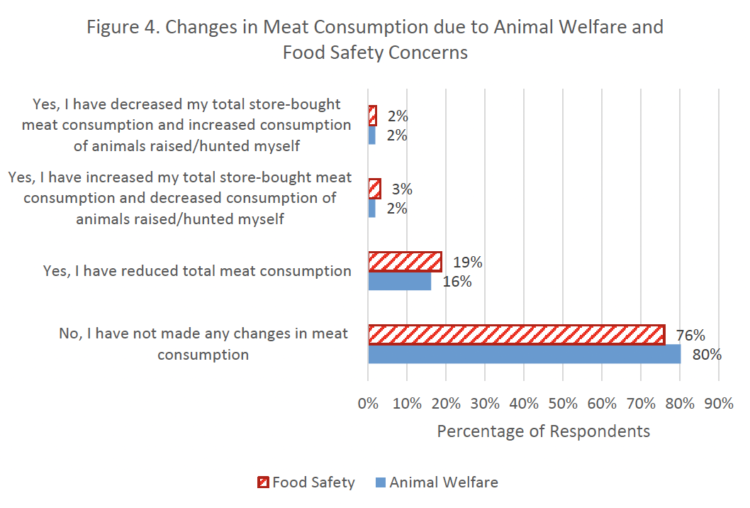Consumer Perceptions of Animal Agriculture: Farmers, Food Safety, and Meat Products
June 13, 2015
PAER-2015-4
Elizabeth S. Byrd, Graduate Assistant, and Dr. Nicole J. Olynk Widmar
Consumers’ perceptions of animal agriculture are increasingly impacting food production systems in the United States. Consumers have been joined by large food retailers and some restaurant chains who have increased their demands about the way animal products are produced. These demands include the space given to each animal, the animals’ freedom of movement, the use of antibiotics, the way animals are handled, and environmental and social impacts of various production systems, as well as others. To align our animal industries with consumer desires, it is critical to better understand their perceptions. To help do this, an online survey of 825 U.S. consumers was conducted in late 2014 to gain insight into their views and perceptions of food safety, farmers, and the animal products they buy.
What We Asked Them
A total of 825 U.S. residents were surveyed online using the Qualtrics survey platform. Global Market Insite (GMI), provided a panel of respondents from their large opt-in panel that were targeted to be representative of the 18 year old and above U.S. population in terms of gender, age, household income, education level, and region of residence. In addition to demographics, respondents were also asked their feelings about food safety, participation in producing their own food, and opinions about the safety of the meat supply.
Who was in the Sample?
Table 1 shows respondent demographics. The average age was 47 years with a household income of $50,169, slightly lower than the median U.S. household income of $53,046 (U.S. Census Bureau, 2014). Respondents spent $220 per week on food with 76%, allocated to food consumed at home (versus away from home).

Table 1. Respondent Demographics (n=825)
Respondents are slightly more educated than the national average with 97% graduating from high school and 33% earning at least a bachelor’s degree. Nationwide, 85.7% of Americans over 25 years of age have graduated high school, and 28.5% have a four year degree (US Census Bureau, 2014). The mean household size for this sample is 2.64 persons and is comparable to the US average of 2.61 persons per household (U.S. Census Bureau, 2014).
Because meat consumption and feelings about meat safety were of particular interest in this study, respondents were asked if they or a member of their household was vegetarian or vegan. Choosing to not consume meat may be related to opinions on food safety, among other factors. Six percent reported that they were vegetarian and 4% reported being vegan. Five percent of respondents reported a member of their household was vegetarian and 4% of respondents reported a vegan member of the household.
Respondents were asked if they were members of a number of organizations. Seven percent of respondents reported being members of the National Rifle Association (NRA). In terms of animal welfare related organizations, 6% reported being members of the Humane Society of the United States (HSUS) and 2% reported being members of People for the Ethical Treatment of Animals (PETA). Three percent were reportedly members of the American Farm Bureau.
Because participation in activities such as hunting and fishing could be related to feelings about food safety, respondents were also asked about their participation. Twenty-four percent of respondents reported regularly fishing and 10% of respondents reported regularly hunting. Of those who hunted, 68% reported that they themselves, or a member of their household, consumed the meat obtained from hunting. Fifty-one percent of respondents did not consume wild game and 17% did not consume fish.
Respondents’ knowledge and experience regarding food production may be related to their feelings about food safety in general. Thus, respondents were asked if they had been actively involved in producing food for their own family in the past three years (Figure 1). Not surprisingly, growing produce, fruit trees, and/or berries was more prevalent than the raising of animals for meat or eggs. Cultivating a garden and/or having fruit trees or berries is understandably more accessible to much of the population, who may live in residences in which caring for animals may be difficult or impossible (but growing produce is more easily accomplished). Thirty-five percent had been involved in growing produce at home while 5% reported growing produce in a community plot or garden (away from home). A total of 16% of respondents reported growing fruit trees or berries. On the other hand, 9% reported raising chickens for eggs and 4% raised chickens for meat. Only 1% of respondents reported raising animals for meat or milk.

Figure 1. Involvement with Food Production
Public Perceptions of Farmers and the U.S. Meat Supply
Respondents were asked their opinions of the safety and quality of meat processed and/or produced in the U.S. relative to meat imported from other countries (Figure 2). Fifty-five percent agreed that meat processed in the U.S. was safer than imported meat. Thirty-nine percent neither agreed nor disagreed with this statement and 6% disagreed with this statement. Fifty-two percent of respondents agreed that meat produced in the U.S. was higher quality than imported meat while 43% neither agreed nor disagreed. Five percent disagreed that meat produced in the U.S. is higher quality than that imported from other countries.

Figure 2. Opinions on the Safety and Quality of U.S. Meat
Respondents were also asked about their perceptions of farmers with regards to the environment and animal welfare (Figure 3). Forty-three percent agreed that farmers care more about animal welfare than the average consumer; 44% neither agreed nor disagreed; 13% disagreed that farmers care more about animal welfare than the average consumer. Thirty-nine percent agreed that farmers care more about the environment than the average consumer; 47% neither agreed nor disagreed; 14% disagreed that farmers care more about the environment than the average consumer.

Figure 3. Perceptions of Farmers
They were also asked if they agreed, disagreed, or neither agreed nor disagreed with the statement “Meat processed in a state or federally inspected facility is safer than self or home processing.” Seventeen percent disagreed with this statement; 36% neither agreed nor disagreed; and 47% agreed that meat processed in a state or federally inspected facility is safer than home processing.
Changes in Consumption due to Food Safety and Animal Welfare Concerns
Respondents were also asked if they had altered their meat consumption due to food safety and animal welfare concerns. Over 75% said they had not made any changes in meat consumption. Sixteen percent had reduced total meat consumption due to animal welfare concerns; 19% had reduced meat consumption due to food safety concerns. (Figure 4)

Figure 4. Changes in Meat Consumption due to Animal Welfare and Food Safety Concerns
Proper Cooking?
Proper cooking is an important food safety procedure for meat products. Thus, consumers’ perceptions of whether they can properly cook meat products can affect demand for those products. The meaning of “properly cook” was intentionally left open to the respondent’s interpretation. Proper cooking could include knowing how to safely cook or how to cook meat so that it tastes good or is appealing. Sixty-eight percent said they know how to properly cook a steak; 34% said they know how to properly cook lamb; 61% said they know how to properly cook a whole turkey. Thus, there are a significant portion of consumers who believe they can properly cook some meat products, but not others. This inconsistency across meat products may be of concern for some livestock species as consumers are less confident in their ability to prepare certain products.

Figure 6. Percent of Respondents who feel they can properly cook Meat Products
Summary and Implications
Increased interest in animal production practices by various consumer groups have prompted many food retailers, processors, and producers to implement changes in production systems to fulfill new consumer demands. Understanding of consumers’ perceptions about meat, including the safety of products and welfare of the animals employed in production can inform decision making by supply chain players.
A majority of respondents in this national survey of 825 consumers felt the U.S. meat supply was safer than imported meat (55%) and was higher quality than imported (52%). Only 43% felt that farmers cared more about animal welfare than the average consumer and just 39% said farmers cared more about the environment than the average consumer. A number said they had reduced their meat consumption due to a food safety issue (19%), or due to an animal welfare issue (16%).
These results suggest that a meaningful number of consumers’ meat consumption has been reduced by food safety and animal welfare concerns. In addition, consumers said they are not very highly convinced that farmers always conduct practices in the best interest of their animals’ welfare nor are farmers as concerned about the environment as the general population. This may suggest that there remains a gap between farmers and consumers and thus supports calls for farm groups to continue efforts to raise standards among producers.
The data analyzed here on perceptions of food safety and animal welfare, and perceptions of respondents of farmers’ level of care/concern presents a small portion of the ongoing analyses on these topics in the Department of Agricultural Economics. You can view more of that work at the following sites:
http://www.vet.purdue.edu/CAWS/files/documents/051815-PerceptionofIndianaStateResidents.pdf
http://agribusiness.purdue.edu/resources/consumer-perceptions-of-livestock-products-and-animal-welfare
http://www.vet.purdue.edu/CAWS/files/documents/outdoor-enthusiasts-perception-of-hunting-and-animal-welfare.pdf
References
U.S. Census Bureau. 2014. State and Country Quick Facts. Available at http://quickfacts.census.gov/qfd/states/00000.html
